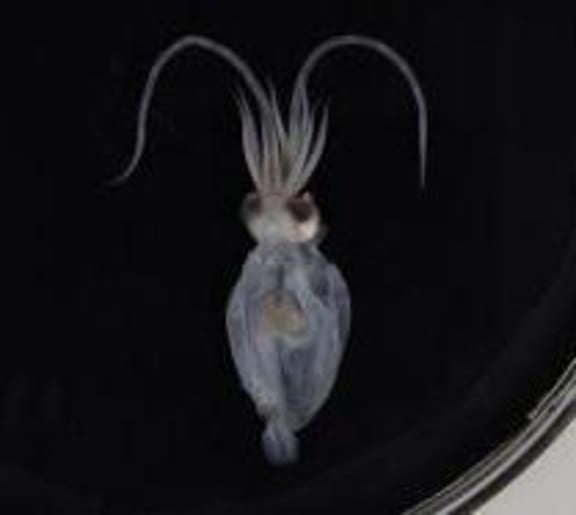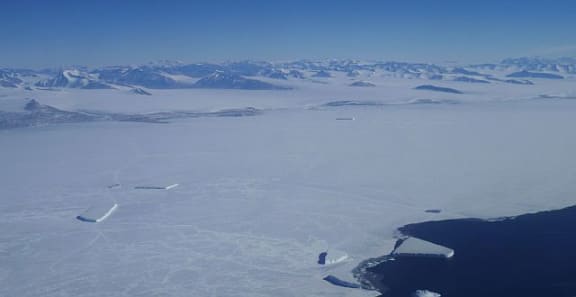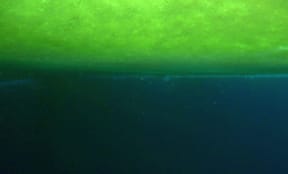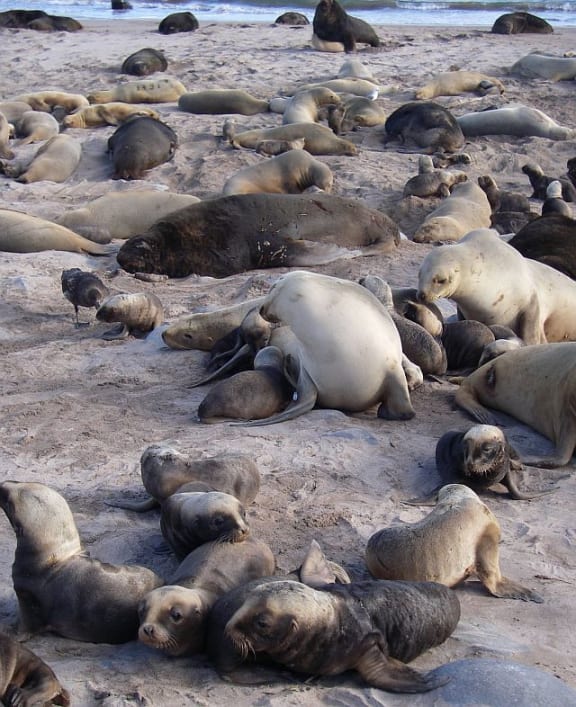By Alison Ballance
The New Zealand Marine Sciences Society held its annual conference in Auckland last week. As anyone who goes to scientific conferences knows, there was wide range of interesting and thought-provoking papers presented. There were nearly 200 presentations over three days, on topics as diverse as estuary dynamics and Maui’s dolphin population modelling, and I thought I’d share some key findings from a handful of researchers in an Our Changing World mini marine conference.
Baby Colossal Squid
“Like most small individuals of the glass squid family when it’s out of the water it looks a little like a deflated plastic bag. We think it’s really cute, of course! It’s got little tiny silly fins on the end, and the mantle is mostly transparent so you can see the organs inside. And it’s got little arms that already have the hooks and suckers on them … and the eyes aren’t the nice round globes you see in the adult, but they’re actually out on very small stalks.”
Kat Bolstad, Auckland University of technology, on a baby colossal squid

This juvenile 12 cm colossal squid could grow to more than 6 metres in length. Colossal squid belong to a family of squid known as the glass squids. Photo: Aaron Evans / AUT & Darren Stevens / NIWA
Kat Bolstad and her team of PhD students from the Lab for Cephalopod Ecology and Systematics (ALCES) at Auckland University of Technology, work on the taxonomy of a range of squid species, from arrow to giant and colossal. Deep sea colossal squid (Mesonychoteuthis) are, of course, famous for their vicious swivelling hooks and can grow up to 6 or more metres. In 2014, Kat was involved in the live stream of a colossal squid dissection at Te Papa, in Wellington. But at the moment Kat is excited about a somewhat smaller specimen: a 12-centimetre long ‘baby’ collected by NIWA earlier this year during the New Zealand-Australia Antarctic Ecosystems Voyage.
The squid is the smallest specimen of colossal squid ever seen, and is half the length of two other small specimens collected by NIWA on an earlier Antarctic expedition.
Colossal squid belong to the squid family Cranchiidae, or “glass squids”, and as the name suggest the young squid is almost completely transparent.
“The timing is perfect,” says Kat, ‘As we’re just working on a paper now about the growth of colossal squid and what they look like in their different life stages.”
Climate Change and Under-Ice Algae in Antarctica

Each winter up to 20 million square kilometres of sea ice forms around Antarctica. In this November photo the fringing sea ice in the Ross Sea is just beginning to break up. Photo: RNZ / Alison Ballance
“We found that as you increase the amount of CO2 in the sea water that the productivity of the algae [under the sea ice] increases, which might make you think that the effects of ocean acidification will be positive. But interestingly, we’ve done some combined experiments with acidification and warming, and when you increase the temperature of the water by 0.4 of a degree … that causes the ice crystals to start to melt, and all this algae drops off the underside of the ice.”
Drew Lohrer, benthic ecologist, NIWA
Drew Lohrer from NIWA is part of a team investigating the effects of climate change on the algae that grows on the underside of Antarctic sea ice. Each spring when light returns to the frozen continent a thick layer of this algae develops, and it’s at the base of the Antarctic food web. To study it in situ the team have developed some innovative chambers.

The bright green algae growing on the underside of the sea ice is like an upside-down meadow, and along with phytoplankton it underpins the entire Antarctic marine food web. Photo: RNZ / Alison Ballance
“We developed these novel incubation chambers, and so as the algae photosynthesise we can measure the production of oxygen to measure their photosynthetic rates,” says Drew. “They’re cylinders made of clear plastic material and they have little air pockets so when scuba divers deploy them we use our own air bubbles to push them up against the under surface of the ice.”
The researchers are able to add varying amounts of carbon dioxide to each of the chambers, which is a proxy for changing levels of CO2 in the atmosphere. As sea water absorbs CO2 the pH is lowered and the water becomes more acidic. The results so far show that the algae, which is mostly diatoms, becomes more productive as CO2 levels increase.
Ocean acidification will affect the ability of calcifying organsims, that use calcium to make, for example, shells, to calcify. Diatoms, however, aren’t calcifying so they aren’t affected in this manner, and instead they use the extra CO2 to increase their rate of photosynthesis.
However, increasing the temperature of the sea water from -1.9°C to -1.4°C causes the algae to slough off the sea ice and fall to the sea floor.
“While you might get a slight positive effect of added CO2 in the sea water, you may get big changes due to increases in the temperature of the sea water,” says Drew.
New Zealand Sea Lions and Population Modelling

Sandy Beach on Enderby Island is one of the key rookeries for New Zealand sea lions. Over the last 15 years the number of sea lion pups produced at the Auckland Islands has halved. Photo: RNZ / Alison Ballance
For many years the subantarctic Auckland islands have been the stronghold for the highly threatened New Zealand sea lion. However in the last 15 or so years the Auckland Islands population has declined to fewer than 10,000 animals, and the number of pups being produced each year has halved. The New Zealand sea lion was recently upgraded to the highest category of ‘endangered’ on the IUCN Red List, and in the New Zealand threat classification system they are listed as “nationally critical” which is the highest threat status.
The decline of sea lions at the Auckland Islands is due to a complicated mix of factors including disease outbreaks, affecting both pups and adults; nutritional stress and changes in diet from animals such as octopuses and large fish to smaller fish; mortality of adults caught as by-catch in the squid and southern blue whiting trawl fisheries. As well, sea lions are preyed on by animals such as great white sharks, and some pups are dying after getting stuck in deep wallows on Enderby Island.
There were several papers presented at the 2015 Marine Sciences Society conference on modelling the impact of sea lion mortality in the southern squid fishery (a fishing area known as SQU6T). Bruce Robertson from the University of Otago is calling for better monitoring of the sea lion excluder devices or SLEDs that the squid trawl fishery uses to try and prevent sea lions drowning in the nets. The SLEDs were introduced in 2001, and as a result live sea lion captures are no longer being reported. However, Bruce says that the lack of monitoring means it is impossible to know if sea lions are drowning in the nets and their bodies being ejected by the SLEDs and not recorded. University of Otago PhD student Stefan Meyer also gave a paper at the conference titled ‘demographic analysis reveals ineffective bycatch mitigation in the Auckland Islands trawl fishery.’ In a recent interview in the Otago Daily Times he said the key to conserving the sea lion population is to focus efforts on adults, rather than pups.
Jim Roberts from NIWA also presented his work analysing population data collected over many years by the Department of Conservation. At the same time as sea lion numbers at the Auckland islands are declining, smaller populations on Campbell and Stewart Islands and in southern New Zealand are increasing, and he says that comparing the differences between the different populations is key to understanding what is happening with the population at the Auckland Islands. MPI and DoC are jointly developing a NZ Sea Lion Threat Management Plan, and Jim is working on a risk assessment model that forms part of this plan.
A Better Net
Plant and Food Research, MPI and the fishing companies Aotearoa Fisheries, Sanford and the Sealord Group have been collaborating to develop a better trawl net. The Precision Seafood Harvesting project began in 2012, and the partners hope that the $48-million investment over six years will result in annual economic benefits of $43.6-million by 2025.
Plant and Food Research scientist Damian Moran says the work so far has focused on the end of the trawl net, which is known as the cod end. They have developed a flexible PVC liner tube that is designed to catch fish, keep them in good condition and also let out undersize ones. Traditionally what happens in trawl nets is that fish continue swimming inside the net, but as they tire in the strong water flow they are swept into the cod end and become caught against the back of the net. The new design dramatically lessens the water flow in the cod end, which allows the fish to continue swimming. When they are brought aboard the boat these fish are in a better state and have much less fin damage than fish caught in traditional nets.
To date trials of the liner have ‘indicated that although fewer undersized snapper escaped the liner than anticipated, the survival rates of fish caught in the liner and then released were higher because they were still swimming inside it when they reached fishing boat decks.’ Damian says that the survival rate of juvenile snapper released after being caught was a very high 80%.
Plant and Food Research’s web site describes the ‘Modular Harvesting System (MHS) as a prototype system that uses an understanding of the physical, physiological and behavioural aspects of fish to target specific species and fish sizes, as well as enabling fish to be landed in a better condition than with traditional harvesting systems. The fish are landed in a live, semi-rested state, maintaining the quality of the animal and increasing its value on the export market.’
The Precision Seafood Harvesting sustainable fishing technology which was a winner at the 2014 New Zealand Innovator Awards and the 2014 KiwiNet Research Commercialisation Awards.

